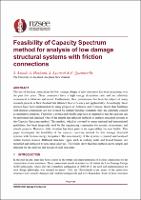| dc.description.abstract | The use of friction connections for low damage design of new structures has been increasing over the past few years. These connectors have a high energy dissipation ratio and are relatively economical to fabricate and install. Furthermore, Their performance has been the subject of many research projects in New Zealand that affirmed their efficiency and applicability. Accordingly, these devices have been implemented in many projects in Aotearoa and overseas. Given that buildings with friction connections are not covered by current building standards, they are generally classed as alternative solutions. Therefore, a robust and reliable approach is required so that the analysis can be performed and checked.
One of the simple and efficient methods to analyse structural systems is the Capacity spectrum method. This method which is covered by many national and international guidelines, has been frequently used by the engineering community for seismic assessment and retrofit projects. However, little attention has been paid to its applicability for new builds.
This paper investigates the feasibility of the capacity spectrum method for low damage structural systems with friction energy dissipators. The nonlinearity of the systems is limited and localised within friction devices. Different structural types, such as rocking walls and braced frames, are modelled and subjected to nonlinear analyses. The results show that the capacity spectra can be simple and efficient for the analysis and design of such structures. | |

